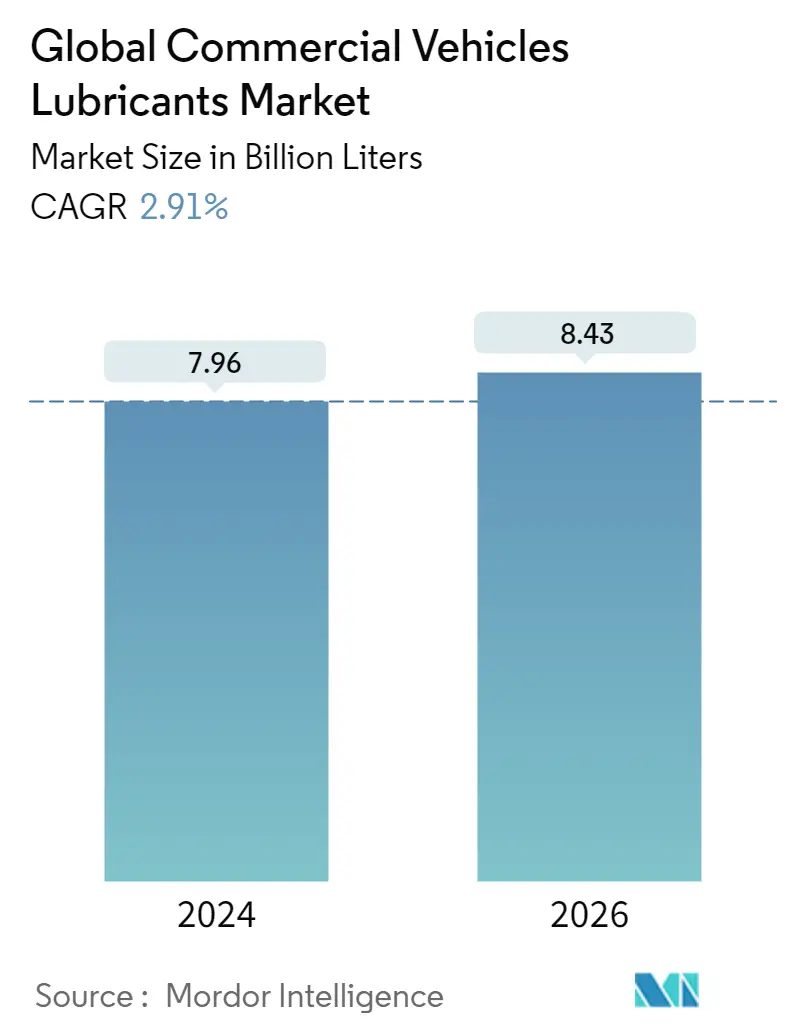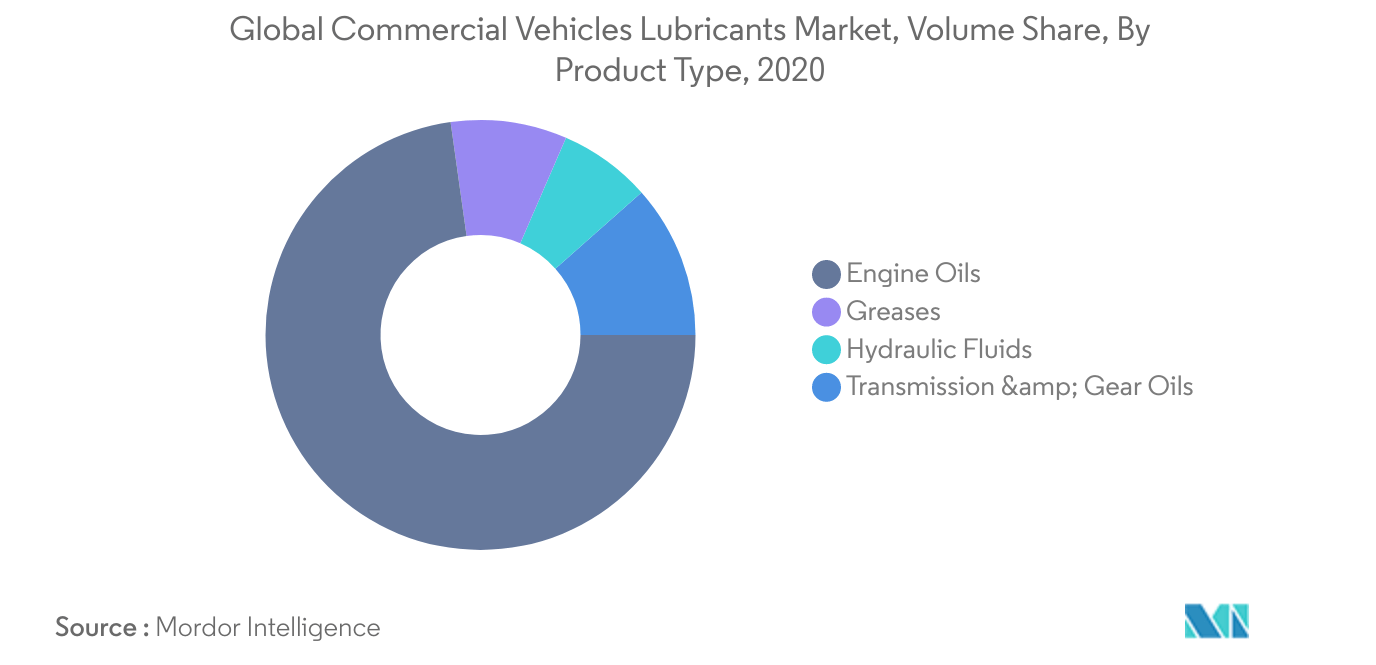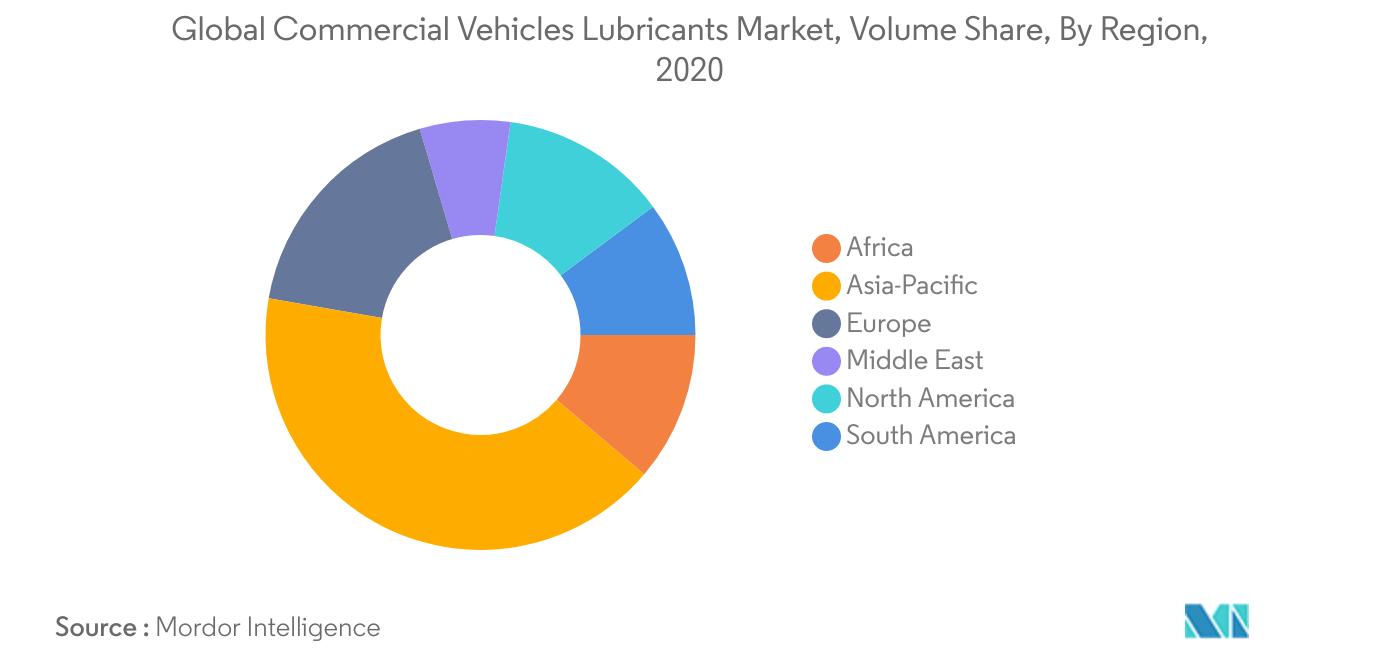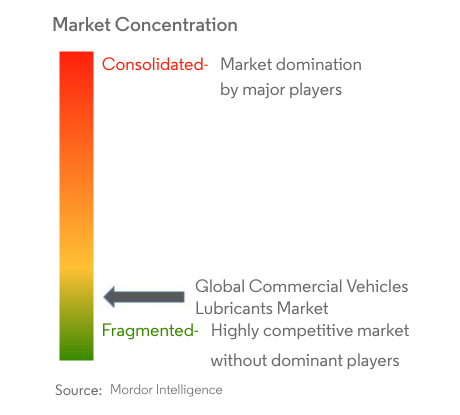Tamaño del mercado de lubricantes para vehículos comerciales

|
|
Período de Estudio | 2015 - 2026 |
|
|
Volumen del Mercado (2024) | 7.96 mil millones de litros |
|
|
Volumen del Mercado (2026) | 8.43 mil millones de litros |
|
|
Concentración del Mercado | Alto |
|
|
Mayor participación por tipo de producto | Aceites de motor |
|
|
CAGR(2024 - 2026) | 2.91 % |
|
|
Mayor proporción por región | Asia-Pacífico |
Jugadores Principales |
||
|
|
||
|
*Nota aclaratoria: los principales jugadores no se ordenaron de un modo en especial |
Análisis del mercado de lubricantes para vehículos comerciales
El tamaño del mercado mundial de lubricantes para vehículos comerciales se estima en 7,96 mil millones de litros en 2024, y se espera que alcance los 8,43 mil millones de litros en 2026, creciendo a una tasa compuesta anual del 2,91% durante el período previsto (2024-2026).
- Segmento más grande por tipo de producto aceites de motor dado que tiene usos a alta temperatura y alta presión, el aceite de motor es el tipo de producto más popular en el sector de CV, con necesidades de gran volumen e intervalos de cambio más cortos.
- Segmento más rápido por tipo de producto aceites para transmisiones y engranajes Se prevé que el consumo de aceite para transmisiones será el más alto entre todas las categorías de productos en el sector global de CV, y se espera que aumente el uso de vehículos comerciales ligeros y camiones.
- Mercado regional más grande Asia-Pacífico Asia-Pacífico alberga países con grandes flotas de vehículos como China, India y Japón. Como resultado, el consumo de lubricantes por parte de este sector fue mayor en Asia-Pacífico.
- Mercado regional de más rápido crecimiento Asia-Pacífico Es probable que la baja penetración de lubricantes sintéticos y las altas tasas de crecimiento esperadas de la flota de camiones en países como India impulsen el consumo de lubricantes en APAC.
Segmento más grande por tipo de producto aceites de motor
- Durante 2015-2019, el consumo de lubricantes en el sector mundial de vehículos comerciales aumentó a una tasa compuesta anual del 2%. El aceite de motor fue el tipo de producto lubricante dominante en este sector, con una participación del 73% en 2020, seguido de los aceites de transmisión, que representaron una participación del 11,5%.
- Durante el brote de COVID-19 en 2020, el transporte de mercancías se redujo significativamente debido a los cierres en respuesta a la pandemia. De esta forma, el consumo de lubricantes en este sector disminuyó un 7,8% respecto a 2019.
- Es probable que el auge previsto de las necesidades logísticas y la recuperación de las ventas de vehículos comerciales nuevos impulsen el consumo de lubricantes en este sector. Por lo tanto, se espera que el consumo de lubricantes para vehículos comerciales aumente a una tasa compuesta anual del 3,2% durante 2021-2026.

Región más grande Asia-Pacífico
- Por geografía, el consumo de lubricante de vehículos comerciales (CV) fue el más alto en Asia-Pacífico, con alrededor del 41,5% del consumo total de lubricantes para CV a nivel mundial, seguido de Europa y América del Norte, que representaron una participación del 17,7% y el 12,6%. respectivamente.
- Las restricciones impuestas a las actividades comerciales y de transporte después del brote de COVID-19 afectaron negativamente el consumo de lubricantes CV en toda la región en 2020. América del Norte fue la más afectada, ya que registró una caída del 12,1% en el consumo durante 2019-2020, seguida de Europa. que registró una caída del 11,8%.
- Durante 2021-2026, es probable que Asia-Pacífico sea el mercado de lubricantes para CV de más rápido crecimiento, ya que es probable que el consumo aumente a una tasa compuesta anual del 4,38 %, seguido de África y América del Sur, con una tasa compuesta anual esperada del 3,09 % y 3,0 %. , respectivamente.

Descripción general de la industria de lubricantes para vehículos comerciales
El Mercado Mundial de Lubricantes para Vehículos Comerciales está fragmentado las cinco principales empresas ocupan el 39,20%. Los principales actores de este mercado son BP PLC (Castrol), Chevron Corporation, ExxonMobil Corporation, Royal Dutch Shell PLC y TotalEnergies (ordenados alfabéticamente).
Líderes del mercado de lubricantes para vehículos comerciales
BP PLC (Castrol)
Chevron Corporation
ExxonMobil Corporation
Royal Dutch Shell PLC
TotalEnergies
*Nota aclaratoria: los principales jugadores no se ordenaron de un modo en especial

Noticias del mercado de lubricantes para vehículos comerciales
- Enero de 2022 a partir del 1 de abril, ExxonMobil Corporation se organizó en tres líneas de negocios ExxonMobil Upstream Company, ExxonMobil Product Solutions y ExxonMobil Low Carbon Solutions.
- Octubre de 2021 Valvoline y Cummins ampliaron su antiguo acuerdo de colaboración tecnológica y de marketing por otros cinco años. Cummins respaldará y promoverá el aceite de motor Premium Blue de Valvoline para sus motores y generadores diésel de servicio pesado y distribuirá los productos Valvoline a través de sus redes de distribución globales.
- Septiembre de 2021 Shell se asoció con ReadyAssist, una empresa de asistencia en carretera las 24 horas con sede en Bengaluru, para brindar un servicio de cambio de aceite sin interrupciones en todo el país. Los clientes pueden obtener un cambio de lubricante gratuito para sus vehículos cuando compren lubricantes Shell a través de ReadyAssist, al que se podrá acceder en hasta 5,500 puntos de venta minoristas de terceros en todo el país.
Informe de mercado de lubricantes para vehículos comerciales índice
1. Resumen ejecutivo y hallazgos clave
2. Introducción
2.1. Supuestos de estudio y definición de mercado
2.2. Alcance del estudio
2.3. Metodología de investigación
3. Tendencias clave de la industria
3.1. Tendencias de la industria automotriz
3.2. Marco normativo
3.3. Análisis de la cadena de valor y del canal de distribución
4. Segmentación de mercado
4.1. Por tipo de producto
4.1.1. Aceites de motor
4.1.2. Grasas
4.1.3. Fluidos hidráulicos
4.1.4. Aceites para transmisiones y engranajes
4.2. Por región
4.2.1. África
4.2.1.1. Egipto
4.2.1.2. Marruecos
4.2.1.3. Nigeria
4.2.1.4. Sudáfrica
4.2.1.5. Resto de África
4.2.2. Asia-Pacífico
4.2.2.1. Porcelana
4.2.2.2. India
4.2.2.3. Indonesia
4.2.2.4. Japón
4.2.2.5. Malasia
4.2.2.6. Filipinas
4.2.2.7. Singapur
4.2.2.8. Corea del Sur
4.2.2.9. Tailandia
4.2.2.10. Vietnam
4.2.2.11. Resto de Asia-Pacífico
4.2.3. Europa
4.2.3.1. Bulgaria
4.2.3.2. Francia
4.2.3.3. Alemania
4.2.3.4. Italia
4.2.3.5. Noruega
4.2.3.6. Polonia
4.2.3.7. Rusia
4.2.3.8. España
4.2.3.9. Reino Unido
4.2.3.10. El resto de Europa
4.2.4. Oriente Medio
4.2.4.1. Irán
4.2.4.2. Katar
4.2.4.3. Arabia Saudita
4.2.4.4. Pavo
4.2.4.5. Emiratos Árabes Unidos
4.2.4.6. Resto de Medio Oriente
4.2.5. América del norte
4.2.5.1. Canada
4.2.5.2. México
4.2.5.3. Estados Unidos
4.2.5.4. Resto de América del Norte
4.2.6. Sudamerica
4.2.6.1. Argentina
4.2.6.2. Brasil
4.2.6.3. Colombia
4.2.6.4. Resto de Sudamérica
5. Panorama competitivo
5.1. Movimientos estratégicos clave
5.2. Análisis de cuota de mercado
5.3. Perfiles de empresa
5.3.1. BP PLC (Castrol)
5.3.2. Chevron Corporation
5.3.3. China National Petroleum Corporation
5.3.4. China Petroleum & Chemical Corporation
5.3.5. ENEOS Corporation
5.3.6. ExxonMobil Corporation
5.3.7. Idemitsu Kosan Co. Ltd
5.3.8. Royal Dutch Shell PLC
5.3.9. TotalEnergies
5.3.10. Valvoline Inc.
6. Apéndice
6.1. Apéndice-1 Referencias
6.2. Apéndice-2 Lista de tablas y figuras
7. Preguntas estratégicas clave para los directores ejecutivos de lubricantes
Lista de Tablas y Figuras
- Figura 1:
- POBLACIÓN DE VEHÍCULOS COMERCIALES, NÚMERO DE UNIDADES, GLOBAL, 2015 - 2026
- Figura 2:
- MERCADO MUNDIAL DE LUBRICANTES PARA VEHÍCULOS COMERCIALES, VOLUMEN EN LITROS, POR TIPO DE PRODUCTO, 2015-2026
- Figura 3:
- MERCADO MUNDIAL DE LUBRICANTES PARA VEHÍCULOS COMERCIALES, PARTICIPACIÓN EN VOLUMEN (%), POR TIPO DE PRODUCTO, 2020
- Figura 4:
- MERCADO MUNDIAL DE LUBRICANTES PARA VEHÍCULOS COMERCIALES, VOLUMEN EN LITROS, ACEITES DE MOTOR, 2015-2026
- Figura 5:
- MERCADO MUNDIAL DE LUBRICANTES PARA VEHÍCULOS COMERCIALES, ACEITES PARA MOTORES, PARTICIPACIÓN EN VOLUMEN (%), POR TIPO DE VEHÍCULO, 2020
- Figura 6:
- MERCADO MUNDIAL DE LUBRICANTES PARA VEHÍCULOS COMERCIALES, VOLUMEN EN LITROS, GRASAS, 2015-2026
- Figura 7:
- MERCADO MUNDIAL DE LUBRICANTES PARA VEHÍCULOS COMERCIALES, GRASAS, PARTICIPACIÓN EN VOLUMEN (%), POR TIPO DE VEHÍCULO, 2020
- Figura 8:
- MERCADO MUNDIAL DE LUBRICANTES PARA VEHÍCULOS COMERCIALES, VOLUMEN EN LITROS, FLUIDOS HIDRÁULICOS, 2015-2026
- Figura 9:
- MERCADO MUNDIAL DE LUBRICANTES PARA VEHÍCULOS COMERCIALES, FLUIDOS HIDRÁULICOS, PARTICIPACIÓN EN VOLUMEN (%), POR TIPO DE VEHÍCULO, 2020
- Figura 10:
- MERCADO MUNDIAL DE LUBRICANTES PARA VEHÍCULOS COMERCIALES, VOLUMEN EN LITROS, ACEITES DE TRANSMISIÓN Y ENGRANAJES, 2015-2026
- Figura 11:
- MERCADO MUNDIAL DE LUBRICANTES PARA VEHÍCULOS COMERCIALES, ACEITES PARA TRANSMISIÓN Y ENGRANAJES, PARTICIPACIÓN EN VOLUMEN (%), POR TIPO DE VEHÍCULO, 2020
- Figura 12:
- MERCADO MUNDIAL DE LUBRICANTES PARA VEHÍCULOS COMERCIALES, VOLUMEN EN LITROS, POR REGIÓN, 2015-2026
- Figura 13:
- MERCADO MUNDIAL DE LUBRICANTES PARA VEHÍCULOS COMERCIALES, PARTICIPACIÓN EN VOLUMEN (%), POR REGIÓN, 2020
- Figura 14:
- MERCADO MUNDIAL DE LUBRICANTES PARA VEHÍCULOS COMERCIALES, VOLUMEN EN LITROS, ÁFRICA, POR PAÍS, 2015-2026
- Figura 15:
- MERCADO MUNDIAL DE LUBRICANTES PARA VEHÍCULOS COMERCIALES, PARTICIPACIÓN EN VOLUMEN (%), ÁFRICA, POR PAÍS, 2020
- Figura 16:
- MERCADO MUNDIAL DE LUBRICANTES PARA VEHÍCULOS COMERCIALES, VOLUMEN EN LITROS, EGIPTO, 2015-2026
- Figura 17:
- MERCADO MUNDIAL DE LUBRICANTES PARA VEHÍCULOS COMERCIALES, EGIPTO, PARTICIPACIÓN EN VOLUMEN (%), POR TIPO DE PRODUCTO, 2020
- Figura 18:
- MERCADO MUNDIAL DE LUBRICANTES PARA VEHÍCULOS COMERCIALES, VOLUMEN EN LITROS, MARRUECOS, 2015-2026
- Figura 19:
- MERCADO MUNDIAL DE LUBRICANTES PARA VEHÍCULOS COMERCIALES, MARRUECOS, PARTICIPACIÓN EN VOLUMEN (%), POR TIPO DE PRODUCTO, 2020
- Figura 20:
- MERCADO MUNDIAL DE LUBRICANTES PARA VEHÍCULOS COMERCIALES, VOLUMEN EN LITROS, NIGERIA, 2015-2026
- Figura 21:
- MERCADO MUNDIAL DE LUBRICANTES PARA VEHÍCULOS COMERCIALES, NIGERIA, PARTICIPACIÓN EN VOLUMEN (%), POR TIPO DE PRODUCTO, 2020
- Figura 22:
- MERCADO MUNDIAL DE LUBRICANTES PARA VEHÍCULOS COMERCIALES, VOLUMEN EN LITROS, SUDÁFRICA, 2015-2026
- Figura 23:
- MERCADO MUNDIAL DE LUBRICANTES PARA VEHÍCULOS COMERCIALES, SUDÁFRICA, PARTICIPACIÓN EN VOLUMEN (%), POR TIPO DE PRODUCTO, 2020
- Figura 24:
- MERCADO MUNDIAL DE LUBRICANTES PARA VEHÍCULOS COMERCIALES, VOLUMEN EN LITROS, RESTO DE ÁFRICA, 2015-2026
- Figura 25:
- MERCADO MUNDIAL DE LUBRICANTES PARA VEHÍCULOS COMERCIALES, RESTO DE ÁFRICA, PARTICIPACIÓN EN VOLUMEN (%), POR TIPO DE PRODUCTO, 2020
- Figura 26:
- MERCADO MUNDIAL DE LUBRICANTES PARA VEHÍCULOS COMERCIALES, VOLUMEN EN LITROS, ASIA-PACÍFICO, POR PAÍS, 2015-2026
- Figura 27:
- MERCADO MUNDIAL DE LUBRICANTES PARA VEHÍCULOS COMERCIALES, PARTICIPACIÓN EN VOLUMEN (%), ASIA-PACÍFICO, POR PAÍS, 2020
- Figura 28:
- MERCADO MUNDIAL DE LUBRICANTES PARA VEHÍCULOS COMERCIALES, VOLUMEN EN LITROS, CHINA, 2015-2026
- Figura 29:
- MERCADO MUNDIAL DE LUBRICANTES PARA VEHÍCULOS COMERCIALES, CHINA, PARTICIPACIÓN EN VOLUMEN (%), POR TIPO DE PRODUCTO, 2020
- Figura 30:
- MERCADO MUNDIAL DE LUBRICANTES PARA VEHÍCULOS COMERCIALES, VOLUMEN EN LITROS, INDIA, 2015-2026
- Figura 31:
- MERCADO MUNDIAL DE LUBRICANTES PARA VEHÍCULOS COMERCIALES, INDIA, PARTICIPACIÓN EN VOLUMEN (%), POR TIPO DE PRODUCTO, 2020
- Figura 32:
- MERCADO MUNDIAL DE LUBRICANTES PARA VEHÍCULOS COMERCIALES, VOLUMEN EN LITROS, INDONESIA, 2015-2026
- Figura 33:
- MERCADO MUNDIAL DE LUBRICANTES PARA VEHÍCULOS COMERCIALES, INDONESIA, PARTICIPACIÓN EN VOLUMEN (%), POR TIPO DE PRODUCTO, 2020
- Figura 34:
- MERCADO MUNDIAL DE LUBRICANTES PARA VEHÍCULOS COMERCIALES, VOLUMEN EN LITROS, JAPÓN, 2015-2026
- Figura 35:
- MERCADO MUNDIAL DE LUBRICANTES PARA VEHÍCULOS COMERCIALES, JAPÓN, PARTICIPACIÓN EN VOLUMEN (%), POR TIPO DE PRODUCTO, 2020
- Figura 36:
- MERCADO MUNDIAL DE LUBRICANTES PARA VEHÍCULOS COMERCIALES, VOLUMEN EN LITROS, MALASIA, 2015-2026
- Figura 37:
- MERCADO MUNDIAL DE LUBRICANTES PARA VEHÍCULOS COMERCIALES, MALASIA, PARTICIPACIÓN EN VOLUMEN (%), POR TIPO DE PRODUCTO, 2020
- Figura 38:
- MERCADO MUNDIAL DE LUBRICANTES PARA VEHÍCULOS COMERCIALES, VOLUMEN EN LITROS, FILIPINAS, 2015-2026
- Figura 39:
- MERCADO MUNDIAL DE LUBRICANTES PARA VEHÍCULOS COMERCIALES, FILIPINAS, PARTICIPACIÓN EN VOLUMEN (%), POR TIPO DE PRODUCTO, 2020
- Figura 40:
- MERCADO MUNDIAL DE LUBRICANTES PARA VEHÍCULOS COMERCIALES, VOLUMEN EN LITROS, SINGAPUR, 2015-2026
- Figura 41:
- MERCADO MUNDIAL DE LUBRICANTES PARA VEHÍCULOS COMERCIALES, SINGAPUR, PARTICIPACIÓN EN VOLUMEN (%), POR TIPO DE PRODUCTO, 2020
- Figura 42:
- MERCADO MUNDIAL DE LUBRICANTES PARA VEHÍCULOS COMERCIALES, VOLUMEN EN LITROS, COREA DEL SUR, 2015-2026
- Figura 43:
- MERCADO MUNDIAL DE LUBRICANTES PARA VEHÍCULOS COMERCIALES, COREA DEL SUR, PARTICIPACIÓN EN VOLUMEN (%), POR TIPO DE PRODUCTO, 2020
- Figura 44:
- MERCADO MUNDIAL DE LUBRICANTES PARA VEHÍCULOS COMERCIALES, VOLUMEN EN LITROS, TAILANDIA, 2015-2026
- Figura 45:
- MERCADO MUNDIAL DE LUBRICANTES PARA VEHÍCULOS COMERCIALES, TAILANDIA, PARTICIPACIÓN EN VOLUMEN (%), POR TIPO DE PRODUCTO, 2020
- Figura 46:
- MERCADO MUNDIAL DE LUBRICANTES PARA VEHÍCULOS COMERCIALES, VOLUMEN EN LITROS, VIETNAM, 2015-2026
- Figura 47:
- MERCADO MUNDIAL DE LUBRICANTES PARA VEHÍCULOS COMERCIALES, VIETNAM, PARTICIPACIÓN EN VOLUMEN (%), POR TIPO DE PRODUCTO, 2020
- Figura 48:
- MERCADO MUNDIAL DE LUBRICANTES PARA VEHÍCULOS COMERCIALES, VOLUMEN EN LITROS, RESTO DE ASIA Y PACÍFICO, 2015-2026
- Figura 49:
- MERCADO MUNDIAL DE LUBRICANTES PARA VEHÍCULOS COMERCIALES, RESTO DE ASIA-PACÍFICO, PARTICIPACIÓN EN VOLUMEN (%), POR TIPO DE PRODUCTO, 2020
- Figura 50:
- MERCADO MUNDIAL DE LUBRICANTES PARA VEHÍCULOS COMERCIALES, VOLUMEN EN LITROS, EUROPA, POR PAÍS, 2015-2026
- Figura 51:
- MERCADO MUNDIAL DE LUBRICANTES PARA VEHÍCULOS COMERCIALES, PARTICIPACIÓN EN VOLUMEN (%), EUROPA, POR PAÍS, 2020
- Figura 52:
- MERCADO MUNDIAL DE LUBRICANTES PARA VEHÍCULOS COMERCIALES, VOLUMEN EN LITROS, BULGARIA, 2015-2026
- Figura 53:
- MERCADO MUNDIAL DE LUBRICANTES PARA VEHÍCULOS COMERCIALES, BULGARIA, PARTICIPACIÓN EN VOLUMEN (%), POR TIPO DE PRODUCTO, 2020
- Figura 54:
- MERCADO MUNDIAL DE LUBRICANTES PARA VEHÍCULOS COMERCIALES, VOLUMEN EN LITROS, FRANCIA, 2015-2026
- Figura 55:
- MERCADO MUNDIAL DE LUBRICANTES PARA VEHÍCULOS COMERCIALES, FRANCIA, PARTICIPACIÓN EN VOLUMEN (%), POR TIPO DE PRODUCTO, 2020
- Figura 56:
- MERCADO MUNDIAL DE LUBRICANTES PARA VEHÍCULOS COMERCIALES, VOLUMEN EN LITROS, ALEMANIA, 2015-2026
- Figura 57:
- MERCADO MUNDIAL DE LUBRICANTES PARA VEHÍCULOS COMERCIALES, ALEMANIA, PARTICIPACIÓN EN VOLUMEN (%), POR TIPO DE PRODUCTO, 2020
- Figura 58:
- MERCADO MUNDIAL DE LUBRICANTES PARA VEHÍCULOS COMERCIALES, VOLUMEN EN LITROS, ITALIA, 2015-2026
- Figura 59:
- MERCADO MUNDIAL DE LUBRICANTES PARA VEHÍCULOS COMERCIALES, ITALIA, PARTICIPACIÓN EN VOLUMEN (%), POR TIPO DE PRODUCTO, 2020
- Figura 60:
- MERCADO MUNDIAL DE LUBRICANTES PARA VEHÍCULOS COMERCIALES, VOLUMEN EN LITROS, NORUEGA, 2015-2026
- Figura 61:
- MERCADO MUNDIAL DE LUBRICANTES PARA VEHÍCULOS COMERCIALES, NORUEGA, PARTICIPACIÓN EN VOLUMEN (%), POR TIPO DE PRODUCTO, 2020
- Figura 62:
- MERCADO MUNDIAL DE LUBRICANTES PARA VEHÍCULOS COMERCIALES, VOLUMEN EN LITROS, POLONIA, 2015-2026
- Figura 63:
- MERCADO MUNDIAL DE LUBRICANTES PARA VEHÍCULOS COMERCIALES, POLONIA, PARTICIPACIÓN EN VOLUMEN (%), POR TIPO DE PRODUCTO, 2020
- Figura 64:
- MERCADO MUNDIAL DE LUBRICANTES PARA VEHÍCULOS COMERCIALES, VOLUMEN EN LITROS, RUSIA, 2015-2026
- Figura 65:
- MERCADO MUNDIAL DE LUBRICANTES PARA VEHÍCULOS COMERCIALES, RUSIA, PARTICIPACIÓN EN VOLUMEN (%), POR TIPO DE PRODUCTO, 2020
- Figura 66:
- MERCADO MUNDIAL DE LUBRICANTES PARA VEHÍCULOS COMERCIALES, VOLUMEN EN LITROS, ESPAÑA, 2015-2026
- Figura 67:
- MERCADO MUNDIAL DE LUBRICANTES PARA VEHÍCULOS COMERCIALES, ESPAÑA, PARTICIPACIÓN EN VOLUMEN (%), POR TIPO DE PRODUCTO, 2020
- Figura 68:
- MERCADO MUNDIAL DE LUBRICANTES PARA VEHÍCULOS COMERCIALES, VOLUMEN EN LITROS, REINO UNIDO, 2015-2026
- Figura 69:
- MERCADO MUNDIAL DE LUBRICANTES PARA VEHÍCULOS COMERCIALES, REINO UNIDO, PARTICIPACIÓN EN VOLUMEN (%), POR TIPO DE PRODUCTO, 2020
- Figura 70:
- MERCADO MUNDIAL DE LUBRICANTES PARA VEHÍCULOS COMERCIALES, VOLUMEN EN LITROS, RESTO DE EUROPA, 2015-2026
- Figura 71:
- MERCADO MUNDIAL DE LUBRICANTES PARA VEHÍCULOS COMERCIALES, RESTO DE EUROPA, PARTICIPACIÓN EN VOLUMEN (%), POR TIPO DE PRODUCTO, 2020
- Figura 72:
- MERCADO MUNDIAL DE LUBRICANTES PARA VEHÍCULOS COMERCIALES, VOLUMEN EN LITROS, ORIENTE MEDIO, POR PAÍS, 2015-2026
- Figura 73:
- MERCADO MUNDIAL DE LUBRICANTES PARA VEHÍCULOS COMERCIALES, PARTICIPACIÓN EN VOLUMEN (%), ORIENTE MEDIO, POR PAÍS, 2020
- Figura 74:
- MERCADO MUNDIAL DE LUBRICANTES PARA VEHÍCULOS COMERCIALES, VOLUMEN EN LITROS, IRÁN, 2015-2026
- Figura 75:
- MERCADO MUNDIAL DE LUBRICANTES PARA VEHÍCULOS COMERCIALES, IRÁN, PARTICIPACIÓN EN VOLUMEN (%), POR TIPO DE PRODUCTO, 2020
- Figura 76:
- MERCADO MUNDIAL DE LUBRICANTES PARA VEHÍCULOS COMERCIALES, VOLUMEN EN LITROS, QATAR, 2015-2026
- Figura 77:
- MERCADO MUNDIAL DE LUBRICANTES PARA VEHÍCULOS COMERCIALES, QATAR, PARTICIPACIÓN EN VOLUMEN (%), POR TIPO DE PRODUCTO, 2020
- Figura 78:
- MERCADO MUNDIAL DE LUBRICANTES PARA VEHÍCULOS COMERCIALES, VOLUMEN EN LITROS, ARABIA SAUDITA, 2015-2026
- Figura 79:
- MERCADO MUNDIAL DE LUBRICANTES PARA VEHÍCULOS COMERCIALES, ARABIA SAUDITA, PARTICIPACIÓN EN VOLUMEN (%), POR TIPO DE PRODUCTO, 2020
- Figura 80:
- MERCADO MUNDIAL DE LUBRICANTES PARA VEHÍCULOS COMERCIALES, VOLUMEN EN LITROS, TURQUÍA, 2015-2026
- Figura 81:
- MERCADO MUNDIAL DE LUBRICANTES PARA VEHÍCULOS COMERCIALES, TURQUÍA, PARTICIPACIÓN EN VOLUMEN (%), POR TIPO DE PRODUCTO, 2020
- Figura 82:
- MERCADO MUNDIAL DE LUBRICANTES PARA VEHÍCULOS COMERCIALES, VOLUMEN EN LITROS, EAU, 2015-2026
- Figura 83:
- MERCADO MUNDIAL DE LUBRICANTES PARA VEHÍCULOS COMERCIALES, EAU, PARTICIPACIÓN EN VOLUMEN (%), POR TIPO DE PRODUCTO, 2020
- Figura 84:
- MERCADO MUNDIAL DE LUBRICANTES PARA VEHÍCULOS COMERCIALES, VOLUMEN EN LITROS, RESTO DE ORIENTE MEDIO, 2015-2026
- Figura 85:
- MERCADO MUNDIAL DE LUBRICANTES PARA VEHÍCULOS COMERCIALES, RESTO DE ORIENTE MEDIO, PARTICIPACIÓN EN VOLUMEN (%), POR TIPO DE PRODUCTO, 2020
- Figura 86:
- MERCADO MUNDIAL DE LUBRICANTES PARA VEHÍCULOS COMERCIALES, VOLUMEN EN LITROS, AMÉRICA DEL NORTE, POR PAÍS, 2015-2026
- Figura 87:
- MERCADO MUNDIAL DE LUBRICANTES PARA VEHÍCULOS COMERCIALES, PARTICIPACIÓN EN VOLUMEN (%), AMÉRICA DEL NORTE, POR PAÍS, 2020
- Figura 88:
- MERCADO MUNDIAL DE LUBRICANTES PARA VEHÍCULOS COMERCIALES, VOLUMEN EN LITROS, CANADÁ, 2015-2026
- Figura 89:
- MERCADO MUNDIAL DE LUBRICANTES PARA VEHÍCULOS COMERCIALES, CANADÁ, PARTICIPACIÓN EN VOLUMEN (%), POR TIPO DE PRODUCTO, 2020
- Figura 90:
- MERCADO MUNDIAL DE LUBRICANTES PARA VEHÍCULOS COMERCIALES, VOLUMEN EN LITROS, MÉXICO, 2015-2026
- Figura 91:
- MERCADO MUNDIAL DE LUBRICANTES PARA VEHÍCULOS COMERCIALES, MÉXICO, PARTICIPACIÓN EN VOLUMEN (%), POR TIPO DE PRODUCTO, 2020
- Figura 92:
- MERCADO MUNDIAL DE LUBRICANTES PARA VEHÍCULOS COMERCIALES, VOLUMEN EN LITROS, ESTADOS UNIDOS, 2015-2026
- Figura 93:
- MERCADO MUNDIAL DE LUBRICANTES PARA VEHÍCULOS COMERCIALES, ESTADOS UNIDOS, PARTICIPACIÓN EN VOLUMEN (%), POR TIPO DE PRODUCTO, 2020
- Figura 94:
- MERCADO MUNDIAL DE LUBRICANTES PARA VEHÍCULOS COMERCIALES, VOLUMEN EN LITROS, RESTO DE AMÉRICA DEL NORTE, 2015-2026
- Figura 95:
- MERCADO MUNDIAL DE LUBRICANTES PARA VEHÍCULOS COMERCIALES, RESTO DE AMÉRICA DEL NORTE, PARTICIPACIÓN EN VOLUMEN (%), POR TIPO DE PRODUCTO, 2020
- Figura 96:
- MERCADO MUNDIAL DE LUBRICANTES PARA VEHÍCULOS COMERCIALES, VOLUMEN EN LITROS, AMÉRICA DEL SUR, POR PAÍS, 2015-2026
- Figura 97:
- MERCADO MUNDIAL DE LUBRICANTES PARA VEHÍCULOS COMERCIALES, PARTICIPACIÓN EN VOLUMEN (%), AMÉRICA DEL SUR, POR PAÍS, 2020
- Figura 98:
- MERCADO MUNDIAL DE LUBRICANTES PARA VEHÍCULOS COMERCIALES, VOLUMEN EN LITROS, ARGENTINA, 2015-2026
- Figura 99:
- MERCADO MUNDIAL DE LUBRICANTES PARA VEHÍCULOS COMERCIALES, ARGENTINA, PARTICIPACIÓN EN VOLUMEN (%), POR TIPO DE PRODUCTO, 2020
- Figura 100:
- MERCADO MUNDIAL DE LUBRICANTES PARA VEHÍCULOS COMERCIALES, VOLUMEN EN LITROS, BRASIL, 2015-2026
- Figura 101:
- MERCADO MUNDIAL DE LUBRICANTES PARA VEHÍCULOS COMERCIALES, BRASIL, PARTICIPACIÓN EN VOLUMEN (%), POR TIPO DE PRODUCTO, 2020
- Figura 102:
- MERCADO MUNDIAL DE LUBRICANTES PARA VEHÍCULOS COMERCIALES, VOLUMEN EN LITROS, COLOMBIA, 2015-2026
- Figura 103:
- MERCADO MUNDIAL DE LUBRICANTES PARA VEHÍCULOS COMERCIALES, COLOMBIA, PARTICIPACIÓN EN VOLUMEN (%), POR TIPO DE PRODUCTO, 2020
- Figura 104:
- MERCADO MUNDIAL DE LUBRICANTES PARA VEHÍCULOS COMERCIALES, VOLUMEN EN LITROS, RESTO DE SUDAMÉRICA, 2015-2026
- Figura 105:
- MERCADO MUNDIAL DE LUBRICANTES PARA VEHÍCULOS COMERCIALES, RESTO DE AMÉRICA DEL SUR, PARTICIPACIÓN EN VOLUMEN (%), POR TIPO DE PRODUCTO, 2020
- Figura 106:
- MERCADO MUNDIAL DE LUBRICANTES PARA VEHÍCULOS COMERCIALES, EMPRESAS MÁS ACTIVAS, POR NÚMERO DE MOVIMIENTOS ESTRATÉGICOS, 2018 - 2021
- Figura 107:
- MERCADO MUNDIAL DE LUBRICANTES PARA VEHÍCULOS COMERCIALES, ESTRATEGIAS MÁS ADOPTADAS, 2018 - 2021
- Figura 108:
- CUOTA DE MERCADO MUNDIAL DE LUBRICANTES PARA VEHÍCULOS COMERCIALES (%), POR PRINCIPALES PARTICIPANTES, 2020
Segmentación de la industria de lubricantes para vehículos comerciales
| Por tipo de producto | |
| Aceites de motor | |
| Grasas | |
| Fluidos hidráulicos | |
| Aceites para transmisiones y engranajes |
| Por región | |||||||||||||
| |||||||||||||
| |||||||||||||
| |||||||||||||
| |||||||||||||
| |||||||||||||
|
Definición de mercado
- Tipos de vehículos - Los vehículos comerciales se consideran dentro del mercado de lubricantes para vehículos comerciales.
- Tipos de productos - A los efectos de este estudio, se tienen en cuenta productos lubricantes como aceites de motor, aceites de transmisión y engranajes, fluidos hidráulicos y grasas.
- Recarga de servicio - La recarga de servicio/mantenimiento se considera al contabilizar el consumo de lubricante para vehículos comerciales, según el estudio.
- Llenado de fábrica - En el estudio se consideran los primeros repostajes de lubricante para vehículos comerciales de nueva producción.
Metodología de Investigación
Mordor Intelligence sigue una metodología de cuatro pasos en todos nuestros informes.
- Paso 1: Identificar Variables Clave: Las variables clave cuantificables (industria y externas) relacionadas con el segmento de producto específico y el país se seleccionan de un grupo de variables y factores relevantes en función de la investigación de escritorio y la revisión de la literatura; junto con las entradas primarias de expertos. Estas variables se confirman aún más a través de la modelización de regresión (si es necesario).
- Paso 2: Construir un Modelo de Mercado: Para construir una metodología de pronóstico sólida, las variables y factores identificados en el Paso 1 se prueban con respecto a los números de mercado históricos disponibles. A través de un proceso iterativo, se establecen las variables necesarias para el pronóstico del mercado y el modelo se construye sobre la base de estas variables.
- Paso 3: Validar y Finalizar: En este paso importante, todos los números de mercado, variables y llamadas de analistas se validan a través de una extensa red de expertos en investigación primaria del mercado estudiado. Los encuestados se seleccionan en todos los niveles y funciones para generar una imagen holística del mercado estudiado.
- Paso 4: Resultados de la Investigación: Informes Sindicalizados, Asignaciones de Consultoría Personalizada, Bases de Datos y Plataformas de Suscripción.






